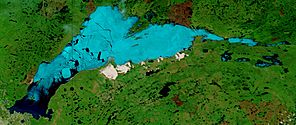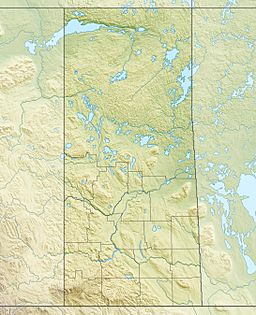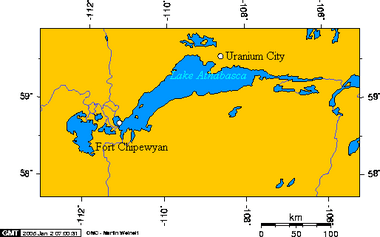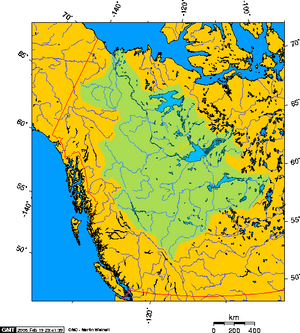Lake Athabasca facts for kids
Quick facts for kids Lake Athabasca |
|
|---|---|

Ice breakup on Lake Athabasca (June 9, 2002)
|
|

Lake Athabasca (August 24, 2002)
|
|
| Location | Division No. 18, Saskatchewan / Wood Buffalo, Alberta |
| Coordinates | 59°16′N 109°27′W / 59.267°N 109.450°W |
| Lake type | Glacial |
| Primary inflows | Peace River, which backs up through Rivière des Rochers during flooding, Athabasca River, William River, MacFarlane River, Colin River, Fond du Lac River, |
| Primary outflows | Rivière des Rochers that meets with the Peace to form the Slave |
| Catchment area | 271,000 km2 (105,000 sq mi) |
| Basin countries | Canada |
| Max. length | 283 km (176 mi) |
| Max. width | 50 km (31 mi) |
| Surface area | 7,850 km2 (3,030 sq mi) |
| Max. depth | 124 m (407 ft) |
| Shore length1 | ≈1,900 km (1,200 mi) |
| Surface elevation | 213 m (699 ft) |
| Settlements | Fort Chipewyan, Uranium City, Camsell Portage, Fond du Lac |
| 1 Shore length is not a well-defined measure. | |
Lake Athabasca is a very large lake in Canada. It sits in the northwest part of Saskatchewan and the northeast part of Alberta. About 26% of the lake is in Alberta, and 74% is in Saskatchewan. The name Athabasca comes from the Cree language. It means "where there are plants one after another."
Contents
History of Lake Athabasca
How the Lake Got its Name
The name for this area first came from the Dene language. It originally described the big delta (a landform at the mouth of a river) where the Athabasca River meets the lake.
In 1789, a famous explorer named Sir Alexander Mackenzie explored the lake. Two years later, in 1791, Philip Turnor, who made maps for the Hudson's Bay Company, wrote about it. He noted that the name "Athapison" came from the Southern Cree language. It meant "open country" with willows and grass growing around lakes.
Another explorer, Peter Fidler, first wrote down the name for the river in 1790 as the Great Arabuska. By 1801, the name was spelled closer to what we use today: Athapaskow Lake. By 1820, George Simpson started calling both the lake and the river "Athabasca."
Geography and Natural Features
Lake Athabasca is huge! It covers about 7,850 square kilometers (3,030 square miles). It is 283 kilometers (176 miles) long and can be up to 50 kilometers (31 miles) wide. The deepest part of the lake is 124 meters (407 feet) deep. It holds about 204 cubic kilometers (49 cubic miles) of water. This makes it the largest and deepest lake in both Alberta and Saskatchewan. It is also the eighth largest lake in all of Canada.
Water from Lake Athabasca flows north. It travels through the Slave River and Mackenzie River systems. Eventually, this water reaches the Arctic Ocean.
Communities on the Lake
Fort Chipewyan is one of the oldest European settlements in Alberta. It is located on the western shore of Lake Athabasca. Here, the Rivière des Rochers flows out of the lake and heads towards the Slave River. This river then begins its journey north, along the eastern edge of Wood Buffalo National Park.
The eastern part of the lake becomes very narrow, about 1 kilometer (0.6 miles) wide. Near this narrow part is the community of Fond du Lac. This community is on the northern shore. The lake continues east to where the Fond du Lac River flows into it.
Important Landmarks
Fidler Point is a spot on the north shore of Lake Athabasca. It is named after Peter Fidler, who was a surveyor and map maker for the Hudson's Bay Company.
Lake Athabasca is also a remnant of a much larger ancient lake. This huge lake, called Glacial Lake McConnell, existed during the Ice Age. Other big lakes like the Great Bear Lake and Great Slave Lake are also parts of this ancient lake.
Rivers Flowing into the Lake
Many rivers and creeks flow into Lake Athabasca. Going around the lake clockwise, some of these are:
- Fond du Lac River
- Otherside River
- Helmer Creek
- MacFarlane River
- Archibald River
- William River
- Ennuyeuse Creek
- Dumville Creek
- Debussac Creek
- Jackfish Creek
- Claussen Creek
- Old Fort River
- Crown Creek
- Athabasca River
- Colin River
- Oldman River
- Bulyea River
- Grease River
- Robillard River
See also
 In Spanish: Lago Athabasca para niños
In Spanish: Lago Athabasca para niños




